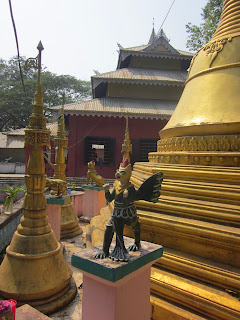 |
| Entry to the Buddhist temple complex in Moheshkhali's Rakhine Para. |
To venture into Rakhine Para of Moheshkhali
Island’s Gorakghata is to step into Southeast Asia. It’s not only the Buddhist
temple complex, glittering in gold, or the Rakhine faces of residents. In the
back alleys the faded frilly facades of some of the old apartment blocks could,
to the newcomer, easily belong in suburban Rangoon. There are examples of
beautiful wooden homes perched on stilts, where family and friends relax beneath,
chatting and taking advantage of the architectural shade. Rakhine Para evidences
a diverse Bangladesh.
 |
| Detail from the temple complex. |
It feels like a neighbourhood where life
returns in familiar patterns with each dawn, year after year. But to speak with
Kyaw Ching, a retired petty naval officer and area resident, in his goldsmith
and pawnbroker’s, is to appreciate that the Rakhines have adopted contemporary
ways.
It used to be that the Rakhine community
primarily engaged in fishing. Ching’s father had four sailing boats for the purpose;
but nowadays in the whole community it’d be difficult to find one.
 |
| At the temple, Rakhine Para. |
“Fishing was dangerous,” says Ching, a
father of three. “Many people died. There’s hardly a family in the village
where someone didn’t die at sea.” Over a decade ago the last of Moheshkhali’s Rakhine
fishing nets were stowed for a final time.
For Rakhine women economic activity also
changed. “Our women don’t sit down,” says Ching, “They like to help support the
family and there used to be a handloom in every house. But there are no
handlooms now.”
 |
| Kyaw Ching with his wife in their goldsmith and pawnbroker business office in Gorakghata's Rakhine Para. |
Cost increase in the price of cotton and
low retail rates for finished items made the area’s longstanding weaving
tradition unviable. These days while local women still try their hand at
sewing, the distinctive Rakhine textiles sold in the market opposite the temple
are imported from Cox’s Bazar or Myanmar.
 |
| One of the temple buildings in Rakhine Para. |
Change has also come to education. Whereas
earlier not every child attended school they now do; yet the younger generation
is losing touch with the Rakhine language, especially the ability to read its
Burmese script. “We used to have a Rakhine teacher,” says Ching, who explains
the difference between the Burmese and Rakhine languages as akin to the difference
between Chittagonian and standard Bangla. “I wish the government could make provision
for a teacher.”
 |
| Local Rakhine women still wear traditional thamis. |
Formerly known as Arakanese, Rakhines trace
their heritage to the establishment of the first independent Rakhine kingdom by
King Marayu in 3325 BCE at Dhanyawadi northeast of Myanmar’s Sittwe. It is said
that Gautama Buddha visited the civilisation during his lifetime.
Subsequent centuries saw the Rakhines
establish a prosperous trading society that stretched into modern day
Chittagong Division and beyond, along the shores of the Bay of Bengal. With
British documents to demonstrate their long-established local presence, the
approximately 3,000 Rakhines living in six Moheshkhali villages are considered
indigenous to the island.
 |
| Rakhine women relaxing in the shade under a traditional stilt house. |
In place of traditional livelihoods a
younger generation of Rakhines have become technicians, mechanics and master
tailors. Goldsmith shops and pawnbroker businesses are prominent.
 |
| A home in traditional Rakhine style. |
“A few have taken government jobs,” says
Ching, who had some work to do to convince his parents decades back to let him
sign up to the Bangladeshi navy where he worked for twenty years. “They thought
of war and worried,” he says, “but afterwards they came to accept it.”
The Rakhines often favour business they can
carry out close to home, fearing discrimination if they embark on lucrative
ventures further afield. “It’s for safety,” says Ching, “We cannot easily
spread out because we don’t have a strong position.” Yet he is the first to
acknowledge Rakhines face no difficulties in Moheshkhali.
 |
| Temple building in Rakhine Para. |
While modernity has brought change to
Rakhine daily life, other aspects remain the same. Women still favour the
Burmese sarong-like thami while among
Rakhine men the signature longyi
(lungee) tied with a prominent knot at the front and worn with shirt tucked in,
is ubiquitous. And at mealtimes of crab, fish or meat with vegetables it can
come as no surprise to detect the wafting aroma of the signature shrimp and
chilli paste called napi, which also
forms part of the cuisine of some hill tracts peoples.
 |
| Nowadays Rakhine textiles are imported from Myanmar. |
This article is published in The Daily Star, here: The Changing Traditions of Moheshkhali's Rakhines
 |
| Temple view, Rakhine Para, Moheshkhali. |
No comments:
Post a Comment